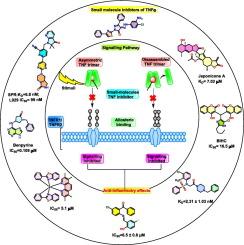揭示小分子肿瘤坏死因子-α (TNF)抑制剂的潜力:全面回顾
IF 3
3区 医学
Q2 BIOCHEMISTRY & MOLECULAR BIOLOGY
引用次数: 0
摘要
TNF-α是一种关键的细胞因子,在自身免疫性疾病和炎症性疾病如类风湿关节炎和牛皮癣的发病机制中起关键作用。因此,TNF-α已成为一个关键的治疗靶点。目前,针对TNF-α的单克隆抗体和诱饵受体被广泛使用,但它们面临着诸如给药挑战等局限性。由于小分子抑制剂具有口服生物利用度、跨越生物屏障的能力和成本效益,这些缺点促使人们探索小分子抑制剂作为替代治疗药物。重要的努力已经指向开发小分子TNF-α抑制剂,其功能是通过破坏TNF三聚体或阻断TNF-α - TNF- fr相互作用。一些候选药物已经进入临床试验阶段,证明了它们作为治疗药物的潜力。本文综述了TNF-α小分子抑制剂的研究进展,包括它们的发现、设计策略、构效关系和生物学评价。此外,它还讨论了当前的临床结果和前景,以指导研究人员在药物设计和开发更有效的抑制剂。本文章由计算机程序翻译,如有差异,请以英文原文为准。

Unravelling the potential of small molecule tumor necrosis factor-α (TNF) inhibitors: A comprehensive review
TNF-α is a key cytokine, plays a critical role in the pathogenesis of autoimmune and inflammatory diseases such as rheumatoid arthritis and psoriasis. As a result, TNF-α has emerged as a pivotal therapeutic target. Currently, monoclonal antibodies and decoy receptors targeting TNF-α are widely used, yet they face limitations such as administration challenges. These drawbacks have driven the exploration of small molecule inhibitors as alternative therapeutic agents due to their oral bioavailability, ability to cross biological barriers, and cost-effective production. Significant efforts have been directed toward developing small-molecule TNF-α inhibitors, which function either by disrupting the TNF trimer or by blocking TNF-αTNFR interactions. Several candidates have progressed to clinical trials, demonstrating their potential as therapeutic agents. This review provides a comprehensive overview of TNF-α small-molecule inhibitors, covering their discovery, design strategies, structure-activity relationships, and biological evaluation. Additionally, it discusses current clinical outcomes and outlook to guide researchers in the drug design and development of more potent inhibitors.
求助全文
通过发布文献求助,成功后即可免费获取论文全文。
去求助
来源期刊

Bioorganic & Medicinal Chemistry
医学-生化与分子生物学
CiteScore
6.80
自引率
2.90%
发文量
413
审稿时长
17 days
期刊介绍:
Bioorganic & Medicinal Chemistry provides an international forum for the publication of full original research papers and critical reviews on molecular interactions in key biological targets such as receptors, channels, enzymes, nucleotides, lipids and saccharides.
The aim of the journal is to promote a better understanding at the molecular level of life processes, and living organisms, as well as the interaction of these with chemical agents. A special feature will be that colour illustrations will be reproduced at no charge to the author, provided that the Editor agrees that colour is essential to the information content of the illustration in question.
 求助内容:
求助内容: 应助结果提醒方式:
应助结果提醒方式:


